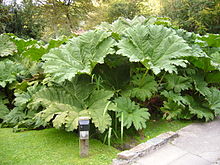
Summary
Gunnera manicata, known as Brazilian giant-rhubarb[1] or giant rhubarb,[2] is a species of flowering plant in the family Gunneraceae from the coastal Serra do Mar Mountains of Santa Catarina, Parana and Rio Grande do Sul States, Brazil.[3][4] In cultivation, the name G. manicata has regularly been wrongly applied to the hybrid with G. tinctoria, G. × cryptica.[5]
| Gunnera manicata | |
|---|---|

| |
| Probably the hybrid with Gunnera tinctoria, Gunnera × cryptica | |
| Scientific classification | |
| Kingdom: | Plantae |
| Clade: | Tracheophytes |
| Clade: | Angiosperms |
| Clade: | Eudicots |
| Order: | Gunnerales |
| Family: | Gunneraceae |
| Genus: | Gunnera |
| Species: | G. manicata
|
| Binomial name | |
| Gunnera manicata | |
Description edit
Gunnera manicata is a large, clump-forming herbaceous perennial growing to 2.5 m (8 ft) tall by 4 m (13 ft) or more. The leaves of G. manicata grow to an impressive size. Leaves with diameters well in excess of 120 cm (4 ft) are commonplace, with a spread of 3 m × 3 m (10 ft × 10 ft) on a mature plant.The largest on record had leaves up to eleven feet (3.3 meters) in width.[6] The underside of the leaf and the whole stalk have spikes on them. In early summer it bears tiny red-green, dimerous flowers in conical branched panicles, followed by small, spherical fruit. Like most gunneras, it has a symbiotic relationship with certain blue-green algae which provide nitrogen by fixation.
Despite the common name "giant rhubarb", this plant is not closely related to true rhubarb. It was named after a Norwegian bishop and naturalist Johan Ernst Gunnerus, who also named and published a description about the basking shark.[7]
Distribution edit
Gunnera manicata is native to the Serra do Mar mountains of coastal Santa Catarina and Rio Grande do Sul states, Brazil, where it is used in traditional medicine for sexually transmitted diseases.[8]
Cultivation edit
In 2022, it was shown that plants in cultivation under the name Gunnera manicata in Britain and Ireland, and likely elsewhere, were actually a hybrid, Gunnera × cryptica.[5] It is primarily cultivated for its massive leaves.[4] It grows best in damp conditions such as near garden ponds, but dislikes winter cold and wet.[9]
In December 2023 it was announced that Gunnera × cryptica (usually grown as Gunnera manicata) was to be subject to a ban in the UK, meaning it cannot be sold or cultivated, and those who have it in their gardens must ensure it does not spread.[10][11]
References edit
- ^ BSBI List 2007 (xls). Botanical Society of Britain and Ireland. Archived from the original (xls) on 2015-06-26. Retrieved 2014-10-17.
- ^ USDA, NRCS (n.d.). "Gunnera manicata". The PLANTS Database (plants.usda.gov). Greensboro, North Carolina: National Plant Data Team. Retrieved 6 January 2016.
- ^ Wanntorp, Livia; Wanntorp, Hans-Erik; Källersjö, Mari (2002-08-01). "The identity of Gunnera manicata Linden ex André - resolving a Brazilian-Colombian enigma". Taxon. 51 (3): 493–497.
- ^ a b RHS A-Z encyclopedia of garden plants. United Kingdom: Dorling Kindersley. 2008. p. 1136. ISBN 1405332964.
- ^ a b Shaw, Julian M.H.; Edwards, Dawn & David, John (2022). "A new spontaneous hybrid in Gunnera subgenus Panke (Gunneraceae) widespread in the British Isles, with notes on the typification of G. manicata". British & Irish Botany. 4 (3): 364–384. doi:10.33928/bib.2022.04.364.
- ^ The Garden Volume 63 issue 1831 (February 21, 1903) page 125
- ^ Froese, R. and D. Pauly. Editors. (2023). FishBase. Cetorhinus maximus (Gunnerus, 1765). Accessed through: World Register of Marine Species at: https://www.marinespecies.org/aphia.php?p=taxdetails&id=105837 on 2023-05-11
- ^ Mariotti, Kristiane de Cássia; Schuh, Roselena Silvestri; Matos Nunes, Jéssica de; Salamoni, Sabrina Pinto; Meirelles, Gabriela; Barreto, Fabiano; Von Poser, Gilsane Lino; Singer, Rodrigo Bustos; Dallegrave, Eliane; Van Der Sand, Sueli Teresinha; Limberger, Renata Pereira (Jan 2014). "Chemical constituents and pharmacological profile of Gunnera manicata L. extracts". Brazilian Journal of Pharmaceutical Sciences. 50 (1). Retrieved 20 December 2016.
- ^ "Gunnera manicata". RHS. Retrieved 22 March 2022.
- ^ Horton, Helena; reporter, Helena Horton Environment (December 8, 2023). "UK bans giant rhubarb after study finds popular garden plant is invasive species" – via The Guardian.
- ^ Gatten, Emma (December 8, 2023). "Sale of common garden plant banned as study reveals it's invasive" – via www.telegraph.co.uk.
External links edit
- Pink, A. (2004). Gardening for the Million. Project Gutenberg Literary Archive Foundation.
- Gunnera manicata


